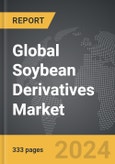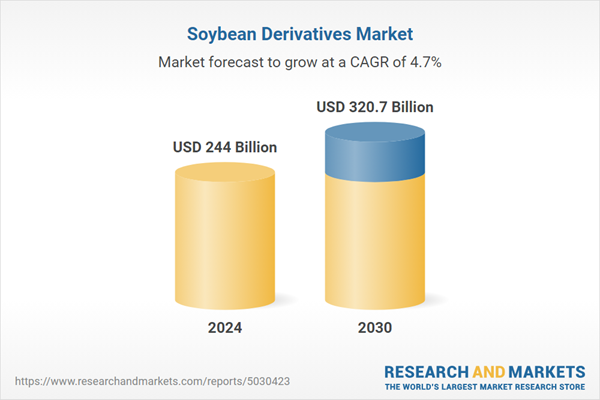The global market for Soybean Derivatives was valued at US$244.0 Billion in 2024 and is projected to reach US$320.7 Billion by 2030, growing at a CAGR of 4.7% from 2024 to 2030. This comprehensive report provides an in-depth analysis of market trends, drivers, and forecasts, helping you make informed business decisions. The report includes the most recent global tariff developments and how they impact the Soybean Derivatives market.
Segments: Type (Soybean, Soy Meal, Soy Oil); Application (Feed, Food, Other Applications).
Geographic Regions/Countries: World; United States; Canada; Japan; China; Europe (France; Germany; Italy; United Kingdom; Spain; Russia; and Rest of Europe); Asia-Pacific (Australia; India; South Korea; and Rest of Asia-Pacific); Latin America (Argentina; Brazil; Mexico; and Rest of Latin America); Middle East (Iran; Israel; Saudi Arabia; United Arab Emirates; and Rest of Middle East); and Africa.
The analysts continuously track trade developments worldwide, drawing insights from leading global economists and over 200 industry and policy institutions, including think tanks, trade organizations, and national economic advisory bodies. This intelligence is integrated into forecasting models to provide timely, data-driven analysis of emerging risks and opportunities.
Global Soybean Derivatives Market - Key Trends and Drivers Summarized
Why Are Soybean Derivatives in High Demand Across Multiple Industries?
Soybean derivatives, such as soybean oil, meal, lecithin, and protein, are in high demand across multiple industries due to their nutritional, functional, and versatile properties. As one of the most widely cultivated and processed crops globally, soybeans serve as a vital source of plant-based proteins, healthy fats, and bioactive compounds. In the food industry, soybean derivatives are extensively used in cooking oils, margarine, bakery products, and dairy alternatives, providing essential nutrients and enhancing flavor and texture. In the animal feed industry, soybean meal is a major ingredient due to its high protein content and amino acid profile, supporting livestock growth and health. Additionally, soybean derivatives are gaining traction in industrial applications, including biodiesel production, industrial lubricants, adhesives, and cosmetics, expanding their market potential.How Are Technological Advancements Transforming the Soybean Derivatives Market?
Technological advancements in soybean processing, extraction, and derivative production are driving innovation in the market, enabling the development of high-quality, functional, and sustainable soybean-based ingredients. The use of advanced extraction techniques, such as cold pressing, solvent extraction, and enzymatic hydrolysis, is improving the yield, purity, and functionality of soybean derivatives, making them suitable for a wide range of food, feed, and industrial applications. The emergence of non-GMO, organic, and clean-label soybean derivatives is also gaining popularity, catering to the increasing demand for natural, sustainable, and health-focused products. Additionally, innovations in biotechnology and fermentation processes are enabling the development of novel soybean derivatives with enhanced nutritional and functional properties, such as high-oleic soybean oil, bioactive peptides, and lecithin alternatives, expanding the application scope of soybean derivatives across various sectors.Which Market Segments Are Leading the Growth of the Soybean Derivatives Industry?
Types of soybean derivatives include soybean oil, soybean meal, soy lecithin, soy protein, and others, with soybean oil holding the largest market share due to its widespread use in cooking, frying, and food processing. Applications of soybean derivatives span food and beverages, animal feed, biodiesel, industrial lubricants, cosmetics, and personal care, with food and beverages being the dominant segment due to the high demand for soybean oil, lecithin, and protein ingredients. End-use sectors comprise food manufacturing, animal feed production, industrial processing, pharmaceuticals, and cosmetics, with animal feed and food manufacturing leading the market due to the extensive use of soybean meal and oil in these sectors. Geographically, North America and South America are the largest markets for soybean derivatives, driven by large-scale soybean cultivation, processing, and export activities, while Asia-Pacific is expected to witness significant growth due to rising demand for soybean-based products and expanding food and feed industries.What Are the Key Drivers of Growth in the Soybean Derivatives Market?
The growth in the soybean derivatives market is driven by several factors, including the rising demand for soybean-based ingredients in food, feed, and industrial applications, technological advancements in soybean processing and derivative production, and the increasing focus on sustainability, health, and wellness. The need to provide high-quality, functional, and versatile soybean derivatives for various applications is driving the demand for soybean-based products. Technological innovations in non-GMO, organic, and bio-based soybean derivatives, coupled with advancements in extraction, fermentation, and biotechnology, are enhancing the quality, functionality, and sustainability of soybean derivatives, supporting market growth. The expansion of soybean derivative applications in biodiesel, industrial lubricants, cosmetics, and pharmaceuticals, along with the growing emphasis on clean label, sustainable sourcing, and environmental impact, is creating new opportunities for market players. Additionally, the focus on developing cost-effective, nutrient-rich, and diverse soybean derivatives for multiple end-use markets is further propelling the growth of the soybean derivatives market.Report Scope
The report analyzes the Soybean Derivatives market, presented in terms of units. The analysis covers the key segments and geographic regions outlined below.Segments: Type (Soybean, Soy Meal, Soy Oil); Application (Feed, Food, Other Applications).
Geographic Regions/Countries: World; United States; Canada; Japan; China; Europe (France; Germany; Italy; United Kingdom; Spain; Russia; and Rest of Europe); Asia-Pacific (Australia; India; South Korea; and Rest of Asia-Pacific); Latin America (Argentina; Brazil; Mexico; and Rest of Latin America); Middle East (Iran; Israel; Saudi Arabia; United Arab Emirates; and Rest of Middle East); and Africa.
Key Insights:
- Market Growth: Understand the significant growth trajectory of the Soybean segment, which is expected to reach US$170.3 Billion by 2030 with a CAGR of a 5.3%. The Soy Meal segment is also set to grow at 4.1% CAGR over the analysis period.
- Regional Analysis: Gain insights into the U.S. market, valued at $64.0 Billion in 2024, and China, forecasted to grow at an impressive 8.3% CAGR to reach $73.8 Billion by 2030. Discover growth trends in other key regions, including Japan, Canada, Germany, and the Asia-Pacific.
Why You Should Buy This Report:
- Detailed Market Analysis: Access a thorough analysis of the Global Soybean Derivatives Market, covering all major geographic regions and market segments.
- Competitive Insights: Get an overview of the competitive landscape, including the market presence of major players across different geographies.
- Future Trends and Drivers: Understand the key trends and drivers shaping the future of the Global Soybean Derivatives Market.
- Actionable Insights: Benefit from actionable insights that can help you identify new revenue opportunities and make strategic business decisions.
Key Questions Answered:
- How is the Global Soybean Derivatives Market expected to evolve by 2030?
- What are the main drivers and restraints affecting the market?
- Which market segments will grow the most over the forecast period?
- How will market shares for different regions and segments change by 2030?
- Who are the leading players in the market, and what are their prospects?
Report Features:
- Comprehensive Market Data: Independent analysis of annual sales and market forecasts in US$ Million from 2024 to 2030.
- In-Depth Regional Analysis: Detailed insights into key markets, including the U.S., China, Japan, Canada, Europe, Asia-Pacific, Latin America, Middle East, and Africa.
- Company Profiles: Coverage of players such as AG Processing Inc., Archer Daniels Midland Company, Bunge Ltd., Cargill, Inc., Chs Inc. and more.
- Complimentary Updates: Receive free report updates for one year to keep you informed of the latest market developments.
Some of the 62 companies featured in this Soybean Derivatives market report include:
- AG Processing Inc.
- Archer Daniels Midland Company
- Bunge Ltd.
- Cargill, Inc.
- Chs Inc.
- DuPont Nutrition & Health
- Louis Dreyfus Commodities B.V.
- Noble Group Limited
- Ruchi Soya Industries Ltd.
- Wilmar International Ltd.
Tariff Impact Analysis: Key Insights for 2025
Global tariff negotiations across 180+ countries are reshaping supply chains, costs, and competitiveness. This report reflects the latest developments as of April 2025 and incorporates forward-looking insights into the market outlook.The analysts continuously track trade developments worldwide, drawing insights from leading global economists and over 200 industry and policy institutions, including think tanks, trade organizations, and national economic advisory bodies. This intelligence is integrated into forecasting models to provide timely, data-driven analysis of emerging risks and opportunities.
What’s Included in This Edition:
- Tariff-adjusted market forecasts by region and segment
- Analysis of cost and supply chain implications by sourcing and trade exposure
- Strategic insights into geographic shifts
Buyers receive a free July 2025 update with:
- Finalized tariff impacts and new trade agreement effects
- Updated projections reflecting global sourcing and cost shifts
- Expanded country-specific coverage across the industry
Table of Contents
I. METHODOLOGYII. EXECUTIVE SUMMARY2. FOCUS ON SELECT PLAYERSIII. MARKET ANALYSISSOUTH KOREAREST OF ASIA-PACIFICARGENTINABRAZILMEXICOREST OF LATIN AMERICAIRANISRAELSAUDI ARABIAUNITED ARAB EMIRATESREST OF MIDDLE EASTIV. COMPETITION
1. MARKET OVERVIEW
3. MARKET TRENDS & DRIVERS
4. GLOBAL MARKET PERSPECTIVE
UNITED STATES
CANADA
JAPAN
CHINA
EUROPE
FRANCE
GERMANY
ITALY
UNITED KINGDOM
SPAIN
RUSSIA
REST OF EUROPE
ASIA-PACIFIC
AUSTRALIA
INDIA
LATIN AMERICA
MIDDLE EAST
AFRICA
Companies Mentioned (Partial List)
A selection of companies mentioned in this report includes, but is not limited to:
- AG Processing Inc.
- Archer Daniels Midland Company
- Bunge Ltd.
- Cargill, Inc.
- Chs Inc.
- DuPont Nutrition & Health
- Louis Dreyfus Commodities B.V.
- Noble Group Limited
- Ruchi Soya Industries Ltd.
- Wilmar International Ltd.
Table Information
| Report Attribute | Details |
|---|---|
| No. of Pages | 333 |
| Published | April 2025 |
| Forecast Period | 2024 - 2030 |
| Estimated Market Value ( USD | $ 244 Billion |
| Forecasted Market Value ( USD | $ 320.7 Billion |
| Compound Annual Growth Rate | 4.7% |
| Regions Covered | Global |









